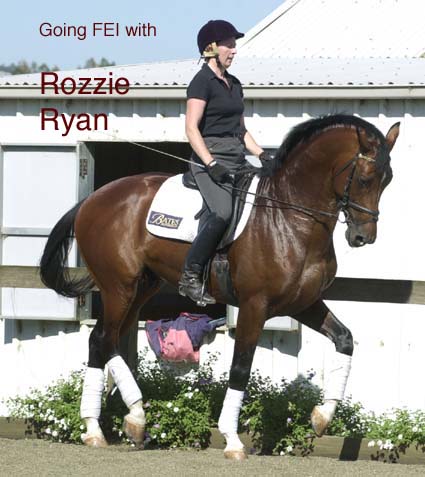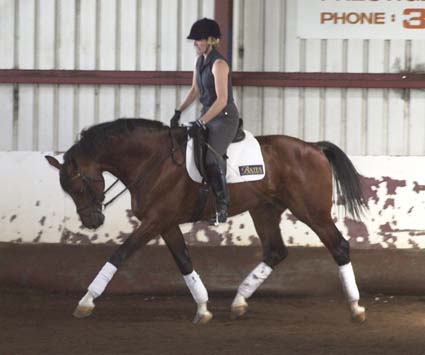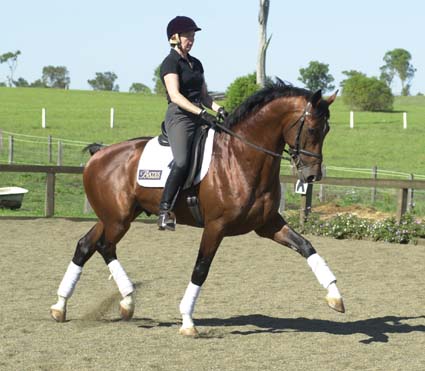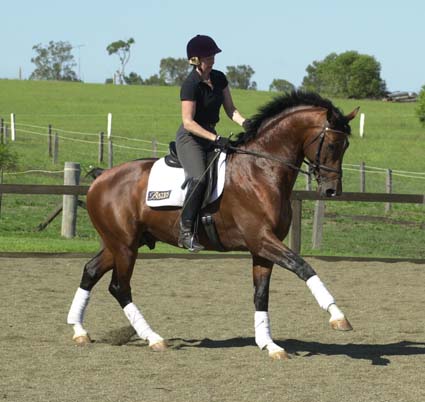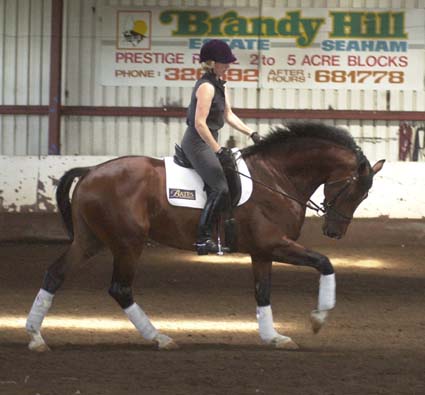Making the Transition
Rozzie Ryan talks about taking Jive Magic into the FEI ranks
After a spectacularly successful career in the lower classes, Rozzie Ryan’s imported son of Jazz, Jive Magic is nibbling at the edges of making the break into the FEI ranks. Here Rozzie talks about the challenge in front of both of them.
“I hope I am still letting him go at his own pace. Pretty much they tell you how quickly you can train them. I’m pretty pleased with the way he is going. He is six and a half now, and he doesn’t feel stressed or stretched in any way. We are working on the piaffe and passage. He is very interested in what we are doing – but always in the past I have been working with very hot horses, and they have been interested but with their interest comes excitement and adrenaline, he doesn’t appear to complicate things like that. He appears to be very interested but doesn’t run adrenaline, it’s quite a novelty for me to have something that shows quite an inclination and is quite highly motivated, but doesn’t run adrenaline with it, even though he’s a stallion. I’m really enjoying that. He is listening and concentrates well, but has a really really nice attitude to work with.”
Do you think it is at least partly that horses like him that are specific bred for dressage find it easier because they have the strength and you are not having to push them the way you would have to push a horse that is bred to race…
“I think with a lot of horses that is the case. Certainly he has quite an inclination to piaffe and passage, it is not a problem for him, therefore he is not struggling to do it, therefore it is not a big deal. I think that does make a big difference – but I have had other horses that haven’t found things particularly difficult. Exellent for example, was kind of an over-achiever and he complicated things whilst you were schooling him. Obviously if the horse finds these things easier to do, it makes it a lot easier to train.”
Watching the working session today, you were introducing the collected movements quite early, is that something you do with all your horses or something that you find works with him?
“I find it works with him. I’ve found with him, because he is such a big loose horse, I’ve wanted to improve the connection. We’ve been having help from Harry Boldt and he says now is the time to make sure you instil this in him – that he sits and uses his hind end. That’s part of the basics and he is six and a half, he needs to know that. It doesn’t stress him, it doesn’t overly stretch him, for another horse it might be too much, but with him he feels great when he comes out of the stable, and I only play with it a little – even in rising trot at the start. Just shortening and going again, and shortening again.”
“I’m just trying to keep him really forward and reaching but without wanting to support himself on the reins, so reaching softly and staying very balanced. I want a really good connection – through and soft.”
Watching you work, it looked as if you were improving the extended trot by using the collected work, rather than getting the collected work from the extended paces? He seems to be one of those horses where the collection improves the extension?
“For sure. I’ve been trying to get him to sit more in his extended trot. He has a very expressive trot but he needed to sit a little more in it, and that really has helped him a lot. Sometimes too, just tapping a little bit on the top of the rump and then going forward in a bigger trot, trot to piaffe and then forward again. He seems to be very capable of holding a good rhythm in that, he doesn’t go and then stutter back, it is not a big effort for him.”
“He looks very enthusiastic in this photo, very expressive. He is pretty awesome to ride in the extended stride. It is not yet always controlled or balanced enough, and I get into trouble from Harry for letting it get too quick, so I am working on that. I guess often with baby horses, when you get power you get speed, and you have to get it straight in your mind, and their mind, that you can have power without speed. I do use quite a lot of piaffe – really half steps – before and after the extended work to get that across to him. I can’t fault his enthusiasm in that photo.”
When you got your big trots slower it was more connected?
“Yes, Harry has been chasing me for that, so I am getting used to slowing the extended trot down. If I can get him to sit enough and then give a little bit – every now and then I get him a bit too short in the neck when I am holding for too long. Once he starts taking weight on the hind legs I can give a lot more and keep the whole frame really good as well.”
Is that a Warmblood problem area, that with their strength and their trainability they can also tend to be a little strung out behind with their hind legs?
“I don’t know that is a Warmblood trait – maybe it is a rider problem. Again I am used to riding these hot horses. Exellent is electric anyway and as you shortened him, he seemed to become more naturally active. Perhaps it is when you have a horse that is a little bit calmer, as you shorten, they might become less active. Maybe that is a rider awareness problem rather than a Warmblood problem. I am sure it is a problem with some Warmbloods, but I am sure there are some Thoroughbreds who have the same problem.”
How did you introduce the piaffe and passage work to Jive – in hand, or did you have someone on the ground?
“No, he and I just played around with it, and basically it just happened. I haven’t worked him in hand because it happened quite easily just out of rising trot, just playing around shortening the trot and it was something he just offered. I have thought about working in hand with him but I haven’t got around to it yet. I feel reasonably confident working them in hand. I worked Exellent in hand and I’ve worked Stilton in hand. He’s had a little bit of Harry helping him from the ground, but basically he has just offered it. I haven’t interfered with it on the ground.”
Do you take care to keep a clear difference between piaffe and passage?
“With him he seems to already have quite a reasonable understanding of the difference. The only thing was his inclination was to be a little hollow, so I make sure that I keep him coming over the back in both the piaffe and passage, and we are still feeling our way there. I would certainly not say that feeling is entirely established, so that is something I work on all the time. Because he has this natural inclination to hold the rhythm, it hasn’t appeared to be too much of a problem shortening and going forward again with the piaffe or passage.”
Was it a problem stopping his working trot becoming passagey?
“He hasn’t shown an inclination to become passagey. He is naturally reasonably active and I think that helps. I think it is very easy to fall into the trap of not going forward enough, but I am lucky, I am surrounded by eventers so it is hard to fall into that trap at our place. If anything we are all fanging around too fast – I am lucky that I am working with a lot of other people around me, and the eventers live too dangerously not to go forward. There are enough eyes around, certainly with Heath – he seems to have eyes in the back of his head – so not going forward is not a problem.”
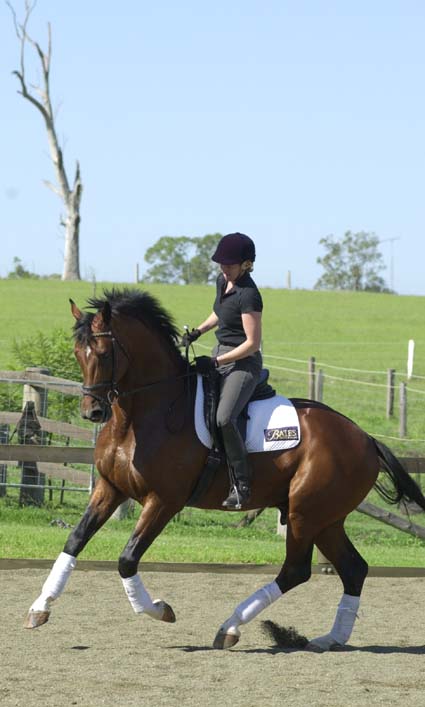 “I love this shot. It is a working pirouette but he looks very balanced and powerful and up in front, but also I like his expression – he is interested and concentrating.
“I love this shot. It is a working pirouette but he looks very balanced and powerful and up in front, but also I like his expression – he is interested and concentrating.
This is one of my all time favourite photos, I love it. I like the lightening tree in the background too!”
What are you working on in the canter?
“In the canter I am trying to get it more active. Get the jump in the canter and at the same time trying to make sure I don’t get him too short in the neck. That’s where I think I sometimes get him too short. We are working on the collection in the canter…”
With working pirouettes?
“I do use those, and again just shortening and lengthening. He didn’t have a problem with walk canter, and canter walk so I have taken to doing the shortening work within the canter itself. I am working on the flying changes, which he seems to have a reasonable grasp of now. I wouldn’t say they are 100% reliable yet but they are feeling really big and expressive, so we are really making headway there now.”
Sequence changes?
“No I haven’t really played with them. When he is feeling really confident, I have probably done three fours at the most. I don’t feel the sequence changes are going to be a problem provided that I make sure I have the single changes 100% reliable and straight and that he has it very clear in his mind.”
“I’m happy with this shot. He is just getting the flying changes organized in his mind. When he gets it right, he feels really expressive. Here it does look expressive and he looks pretty confident, good through the neck.”
Is it necessary with a younger horse to slightly give away your seat, as you have done in this photo?
“I was just going to say I look as if I am sitting forward a little bit. It wasn’t necessarily a conscious thing. I’m probably more of a feel type rider than a powerful-type rider and maybe that’s my thing. Flying changes are a personal thing. I would think ideally I should be sitting upright, not leaning forward. I guess another rider might have ridden it a lot more powerfully. Ideally I would see me sitting more upright but that is the rider I am, I’m trying to be sympathetic because he is only starting to get the idea organized in his mind, and you try not to interfere too much. You try to set it up as much as you can, and then my thing is to not interfere.”
You work him inside most of the time?
“No, I work him outside. He is actually good inside or outside, it is just that the going in our outdoor arena is a little heavy so I don’t work him an awful lot out there. I take him for a little walk every now and then, but mainly he works inside. We are in the middle of serving mares at the moment, but I don’t have anything to do with that, so he only associates me with the riding, not the breeding work. He’s got that quite organized in his mind and I find he has a really really good attitude at the moment even though he is in the middle.”
You don’t see it as a problem, a breeding stallion and a competition horse?
“I really don’t notice that much difference between the winter months and the breeding season. The only thing you have to watch is if he is serving twice a day and it is really hot, he can get tired. He is still only a young horse.”
And reacting to other horses, is that a problem?
“No, he is very good. If they are reasonably sensible I think they work out very quickly. It is clear in his brain, when he gets a saddle and a bridle on, that’s it. He concentrates.”
How do you plan a working session?
“I play it very much by ear, by what I feel. I don’t have a pre-conceived idea when I get on. Today I am going to do this. I usually have the same warmup. I warmup in walk, then rising trot, then canter and shorten and lengthen, and go back to sitting trot. Work on some lateral work. Some days I’ll play with the piaffe / passage, and other days I’ll leave it. Mostly I’ll work my way through everything we are working on, but if I feel he is a little tired I might back off, and if he is a little fresh, he might get more work and we’ll really work on the flying changes.”
The lateral work hasn’t been a problem?
“No it has been very easy for him. I start lateral work on the circle. Just moving the horse a little bit off the leg into either bend, then shoulder in, renvers, travers… all on the circle and then on straight lines. Just making sure the horse is flexible and they understand that they listen to the leg.”
How much work does he need?
“Again depending on what he is doing. If it is quite hot and he is serving, then he doesn’t get so much. I guess once the stud season dies down and the competitions are starting, the work load steps up – he probably works about 45 minutes a day.”
Do you put him out?
“No, he doesn’t go out. He’s got a stallion run he can go out in, but it is right near the mare barn, so he doesn’t go out in breeding season. It would suit me much better for him to go out. I don’t think standing in the stable twenty three hours a day is ideal, but if he comes out to serve twice a day and be ridden that’s enough. Ideally I would have a yard for him to go out in.”
When is he going FEI?
“I guess he will tell me really. I don’t think it is that far off, but I think he is good enough that I am not in a hurry to do it. I feel it will be this year, but I can’t tell you exactly when. When I feel he is going to go out and do a good job. I don’t have a timetable. I don’t say one month doing the test at home, then he is ready to go out and do it. or six months at home and we are ready to go. I think it is very much up to the horse and how you feel about it. I feel it is fairly close, but I’m not going to put a time line on it.”
Is he the same horse at a competition as he is at home?
“Pretty much. I’ve been very happy with him. At the nationals he was a little bit spooky when I took him up to the top arena where they had those judges boxes, and I wondered how he’d be heading straight towards one, but he was solid as a rock, he didn’t look at anything. I was really really pleased with that because when I took him up there he was quite scared.”
You spent quite a lot of time in Holland with Tineke Bartels, who has trained quite a bit with Anky van Grunsven and Sjeff Janssen – did you ever come to a conclusion about how useful those teachings of Sjeff’s are?
“Tineke has a very basic principle, that is very difficult to achieve, and it’s making the horse totally flexible. You make him longitudinally flexible, and he has got to be able to reach as much as you want, but again without supporting himself on the rein. In the end you have got to be able to ride him as high or as low as you want to – and he also has to be laterally very flexible, and he has got to be flexible within the pace, you need to be able to control the tempo. You have to be able to do all that very fluidly and easily in all paces, all movements, any time you want. But that is very difficult to achieve. That is my interpretation of what Tineke was talking about, so you had control of the tempo and flexibility of the horse at all times.”
Looking at this photo, Sjeff would want you to drop the horse’s head another half a metre?
“Yes, that is what I’m working on. I should be able to drop the horse’s head I should be able to drop it as low as I want, any time. I’m not saying I would necessarily ride around with the head very low for a long time, I have to interpret this and be able to feel I can control what I am doing. If I want to put his head up two feet, or down two feet, I should be able.”
But you don’t feel as Sjeff seems to, any compelling need to gymnasticise the horse by working him in the super round and low frame?
“Far be it from me to say what Sjeff thinks. I’ve only really read what Sjeff thinks, and watched what Anky’s does, and they have been so incredibly successful that I don’t really feel that I can comment on what they do. I totally admire the results they produce. But yes, if I want to put his head two feet lower than it is in the picture, I should be in control enough to do that without him supporting himself, just gently reaching more. I don’t spend ages there, I guess it would depend on the horse. Jive feels so loose when you get on him, that I don’t spend a lot of time down there. I guess that is because I don’t necessarily feel comfortable with it, whether it is right or wrong time will tell. Because I am training by myself or with Heath watching or with Harry Boldt, I tend to work along their lines. I am working with this horse, particularly in the canter so I can get the neck longer. I do feel sometimes particularly in canter, that the neck comes too short. It is something I am working on.”

